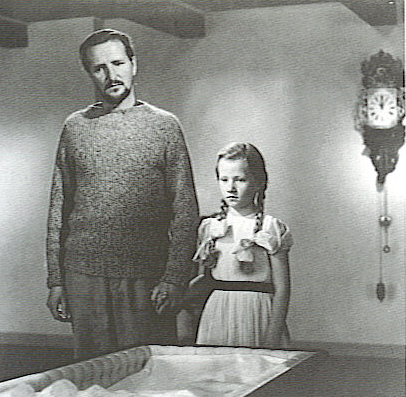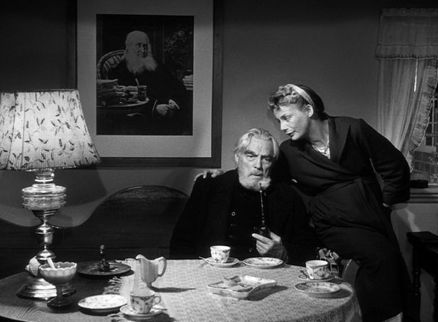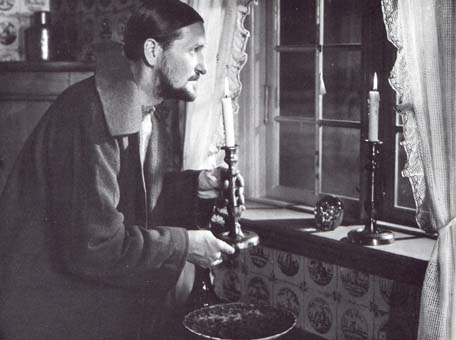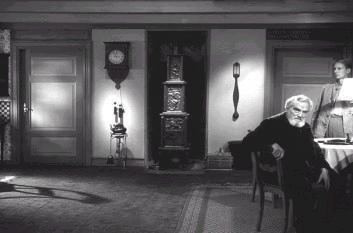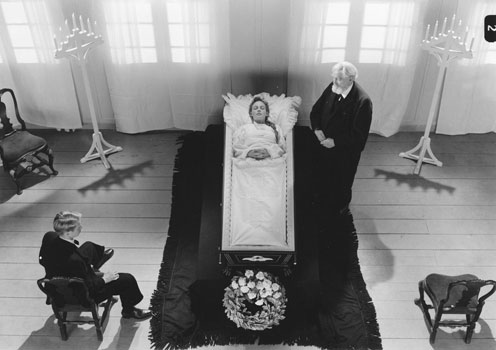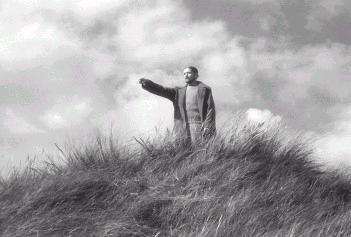Like my essay on Dreyer’s Day of Wrath, this essay was written for an Australian DVD, which came out in 2008 on the Madman label. (One can order these and many other DVDs, incidentally, from Madman’s site.) My thanks to Alexander Strang for giving me permission to reprint this. (It’s also reprinted in my most recent collection, Goodbye Cinema, Hello Cinephilia. —J.R.
Mise en Scène as Miracle in Dreyer’s Ordet
by Jonathan Rosenbaum
Ordet (The Word, 1955) was the first film by Carl Dreyer I ever saw. And the first time I saw it, at age 18, it infuriated me, possibly more than any other film has, before or since. Be forewarned that spoilers are forthcoming if you want to know why.
The setting and circumstances were unusual. I saw a 16-millimeter print at a radical, integrated, co-ed camp for activists in Monteagle, Tennessee — partially staffed by Freedom Riders, during the late summer of 1961, when we were all singing “We Shall Overcome” repeatedly every day. So the fact that Ordet has a lot to do with what looked like a primitive form of Christianity — combined with the particular inflections brought by the black church to the Civil Rights Movement, including one of its appropriated hymns — had a great deal to do with my rage. I was an atheist who’d grown up attending a Reform Jewish temple in northwestern Alabama, surrounded by white Christians in the segregated schools I’d attended. The fact that Ordet, based on a celebrated play by the Lutheran pastor Kaj Munk — a famous martyr of the Danish resistance who received a bullet in the head for his denunciation of the Nazis — ends with a Christian miracle after very persuasively sowing religious doubts and skepticism for roughly its first two hours seemed like an ultimate gesture of hypocrisy and deceit. And maybe because I’d been sufficiently moved and even devastated by the preceding tragic story, in which a remote family of Christian farmers in Jutland loses its only mother, Inger, the story’s most vibrant and generous character, after she gives birth to a son who also dies, I was especially ill-prepared for the coup de théâtre and miracle of her sudden resurrection. Worst of all, it was brought about by her brother-in-law Johannes, who up until this final scene has been a crazed religious fanatic calling himself Jesus Christ. As far as I could tell, this was as crass an about-face as a film could make —- a cynical reversal whereby everything the film had been carefully propounding about the futile despair that often derives from faith and religious belief was instantaneously and inexplicably refuted.
Almost half a century later, it’s easier for me to see that the film poses an irresolvable challenge to believers and unbelievers alike — and that what drove me nuts as a teenager is far from unconnected to what makes me consider Ordet one of the greatest of all films today. The experience of the film demands a certain struggle, regardless of one’s beliefs, and the fact that it can’t be easily processed or rationalized or filed away is surely connected to what keeps it alive and worrying (though try telling that to an irate 18-year-old). And it obviously bears some relation to what makes, in Dreyer’s preceding and following masterpieces, medieval witch-hunts and executions a deadly game in which the accused parties are every bit as gullible, as superstitious, and as complicitous as their accusers (in the 1943 Day of Wrath)or makes a beautiful singer who renounces all her romantic relationships in turn because of her impossible ideals about love both an absolute monster and a martyred saint, not even alternately but simultaneously (in the 1964 Gertrud).
It’s surely a tragedy that Dreyer managed to make only five sound features. Discounting his 1944 Swedish film Two People — which he understandably disowned after he lost control of its casting, and which is, indeed, a paltry thing alongside his 1932 Vampyr, Day of Wrath, Ordet, and Gertrud, all incontestable masterpieces —- this amounted to only one feature per decade, none of them including his dream project about Jesus, which occupied him for most of his later years. And out of these four sublime features, Ordet is understandably the one he was happiest with, both because it had the largest public success and because the experience of making it was, from all indications, far more relaxed than the others had been (or, in the case of Gertrud, would be). It was also conceivably, with the possible exception of Gertrud, the most personal of his sound films, for reasons that can perhaps be understood only if one considers Dreyer’s biographical origins.
But before getting to the project’s personal aspects, let’s take a look at what made the production of Ordet relatively relaxed and untroubled for Dreyer. For one thing, he started work on the project not long after he received a special, prestigious grant from the Danish government in 1952 that consisted of a free license to operate a prominent film theater in Copenhagen, the Dagmar, and which gave him economic security for the remainder of his life.(Built as a legitimate theater in the late 19th century and converted into a cinema in 1939, the building also housed a suite of offices, and ironically had been used by the Germans as Gestapo headquarters during the war. Dreyer happily ran it as a commercial theater and not simply as an art cinema—–some of its more successful crowd-pleasers included Carmen Jones, East of Eden, Baby Doll, and a revival of Gone with the Wind, although it also premiered Ordet.)
Dreyer also had the advantage of working with a very harmonious and skillful cast — including, as Johannes Borgen, Preben Lerdorff-Rye, who had previously played Martin, a major role in Day of Wrath. (The two parts and performances are so dissimilar that many people familiar with both films are unaware that the same actor plays in both, unless they look at the respective cast lists.) Birgitte Federspiel, in the major role of Inger, was the daughter of Einar Federspiel, who played Peder Skraedder, a tailor and a member of the Inner Mission (a rival and more fundamentalist faction of the Danish Lutheran Church than the more popular and liberal Grundtvigian faction subscribed to by the Borgen family); but in the original stage production of Ordet, Einar Federspiel had played the tailor’s rival, old Morten Borgen. Meanwhile, the actor originally intended to play Morten Borgen on the stage, Henrik Malberg, who’d been unable to take the role because of his contract with the Royal Theater at the time, finally got to play him in the film at the age of 81. (The parts of both Anders, the youngest son in the Borgen family, and Anne, the daughter of the tailor whom he falls in love with, were played by nonprofessionals.)
It also appears that Dreyer had all the time and budget he needed to make the film. Not only was someone hired to train all the actors to speak with the proper Jutland accents in a way that could be understood by the general Danish public, but Dreyer even managed to purchase a farm there and then transport it piece by piece to a studio soundstage in Copenhagen — before stripping it down to essentials. (Most famously, he reportedly outfitted the Borgen kitchen in the studio with over a hundred implements and then carefully removed most of them, one at a time, until arriving at what he regarded as the essentials which wouldn’t distract the viewer.) And he also remained in Jutland long enough to shoot most or all of the exteriors. More generally, he had enough time to rehearse each scene for a few days while the elaborate tracks for the camera movements would be laid out and the extremely difficult and subtle lighting schemes were plotted with Henning Bendtsen, the same gifted cinematographer who would later also shoot Gertrud. (What made the lighting especially tricky is the fact that each character is lit separately and in a somewhat different way from the others — which is made even more difficult when the camera and the characters that are followed are in almost perpetual motion . Johannes, to take one extreme example, mainly moves about in relative darkness, and becomes fully lit only in the final sequence.) It seems characteristic of the relaxed quality of the shooting that the final scene, associated closely in our minds with daylight, was actually shot exclusively at night in order to escape from the distractions that might have been posed by others working at the same studio. And the execution of all the film’s long takes proved to be so focused and satisfactory that Dreyer managed to edit the entire film in only five days — the same length of time, according to Jean and Dale D. Drum (1), that it took Kaj Munk to write the original play.
***
How was Ordet a personal project for Dreyer? According to his major biographer — the late Maurice Drouzy, whose groundbreaking, 1982 Carl Th. Dreyer né Nilsson has been published in French and in Danish but lamentably not in English — and contrary to most would-be reference works, Dreyer’s upbringing was neither strict nor Lutheran, and he was born a Swede, even if he grew up in Denmark. He was born illegitimately in 1889 to Josefine Bernhardine Nilsson, an unmarried, 33-year-old Swedish servant living and working in a large country estate — a woman who died horribly a year and a half later trying to abort a second child in her seventh month of another pregnancy by taking a box and a half of matches, cutting off their heads, and swallowing them, which led to a painful and hideous death from sulfur poisoning. (The father or fathers responsible for the two pregnancies are unknown.) It appears that Dreyer himself eventually learned about the fate of his mother as a young man, and for Drouzy this became the key determining factor in his work; the second and longest part of his biography, covering all of Dreyer’s career as a filmmaker, is entitled “The Monument to the Mother”. And clearly much of the cinema of Dreyer is preoccupied with the extreme suffering of women. So the fact that Inger in Ordet dies from childbirth after her baby is aborted and cut into four pieces by the doctor, and then becomes miraculously brought back to life again, surely must have had a deep and complex personal resonance for the filmmaker. Existentially speaking, Dreyer himself could have been aborted by his mother, and the fact that she inadvertently killed herself while desperately trying to abort a second child surely must have given him a lot to brood over.
Returning to his infancy, after brief periods with foster parents, in an orphanage, and then with another family, the baby was adopted by the Dreyers in Copenhagen — a typographer named (as his adopted son would be) Carl Theodor Dreyer and his wife Marie, who already had an illegitimate daughter named Valborg. Marie, who felt cheated that the infant Carl’s real mother hadn’t lived long enough to pay child support, reportedly made a habit of complaining to her adopted son about it, and often punished him by locking him in a closet. He grew up despising her, and when she died many years later, he refused even to attend her funeral.
According to Drouzy — whose biography of Dreyer was initially written as a dissertation in Denmark and refused as one, most likely because his meticulously researched account of Dreyer’s autobiographical obsessions is itself so obsessive — Dreyer worshiped his real mother and hated his adopted one, and good as well as bad mother figures subsequently abound in his films.
Although at the age of two he was christened in a Lutheran church, Dreyer the future filmmaker was essentially brought up nonreligiously. When he later went to Sunday school at a French Reformed church, this was reportedly mainly done in order to sharpen his French, though it’s possible—and this is my hypothesis, not necessarily Drouzy’s—that the French Huguenot concept of arbitrary grace, the belief (which might be said to underline most of the action unfolding in Ordet, before the miracle) that God’s will is not manifested in response to prayer or good deeds, left a certain mark on him.
In any event, what I and many others had originally taken to be deep-seated and rigid religious beliefs on the part of Dreyer were actually calculated challenges to belief and nonbelief, believers and nonbelievers, alike. And according to what Dreyer’s friend Ib Monty once told me, he wasn’t especially religious at all. Indeed, Dreyer even made sure to direct Lerdorff-Rye’s performance as Johannes in order to make the character as irritating and as creepy as possible, patterning his high-pitched intonation specifically after that of someone in a mental asylum whom Dreyer took his actor to meet. (This intonation disappears when Johannes regains his sanity in the final scene, but as Lerdorff-Rye pointed out in later interviews, his performance was widely criticized even by some critics who loved the film — Tom Milne in his book on Dreyer is a case in point — simply because he followed Dreyer’s instructions precisely.)
Dreyer’s own way of accounting for or at least rationalizing the miracle at the end of Ordet is a rather curious and convoluted one that deserves to be examined in some detail. In a letter written to Film Culture the year after Ordet was released (1957, no. 7), he responded to the charge of critic Guido Aristarco that “it is disconcerting to find Dreyer, in this atomic age synthesized by Einstein’s equations, rejecting science for the miracles of religion.” To refute this charge, Dreyer twice quoted from a September 1954 interview that he gave on Danish State Radio before the film was completed. First he recalled attending the very first performance of the play at the Betty Nansen Theater in 1932: “I was deeply moved by the play and overwhelmed by the audacity with which Kaj Munk presented the problems in relation to each other. I could not but admire the perfect ease with which the author put forth his paradoxical thoughts. When I left the theater, I felt convinced that the play had wonderful possibilities as a film.” And in fact, Dreyer published a major essay the following year, “The Real Talking Film” (1933), in which he outlined what some of those possibilities were — which he realized precisely when he finally was able to make the film:
Characteristic of all good film is a certain rhythm-
bound restlessness, which is created partly through the
actors’ movements in the pictures and partly through a
more or less rapid interchange of the pictures
themselves. A live, mobile camera, which even in
close-ups adjusts flexibly and follows the persons so
that the background is constantly shifted (just as for the
eye, when we follow a person with our eyes), is
important for the first type of restlessness. As for the
interchange of images, it is important when the
manuscript is adapted from the play that the play
provide as much “offstage” as “onstage” action. This
creates possibilities for new rhythm-making elements.
Example: the third act of Kai Munk’s Ordet takes
place in the drawing room of the Borgen family’s farm.
Through the conversation of those present, we learn that
the young woman who is to give birth has become ill
suddenly and put in bed and that the doctor who has
arrived in haste fears for her life and the baby’s life.
Later, we learn first of the baby’s death and after that of
her death. If Ordet were to be filmed, all these scenes in
the sickroom, which the theatre audience gets to know
only through conversation, would have to be included in
the film. The actors going to and from the sickbed would
contribute to creating the two kinds of restlessness or
excitement that condition the rhythm of the film to an
essential degree.
Returning to Dreyer’s letter to Film Culture, his second quote from his interview on Danish radio was a response to the question of when he wrote his script for Ordet:
It did not happen until nearly twenty years later. Then I
saw Kaj Munk’s ideas in a different light, for so much
had happened in the meantime. The new science that
followed Einstein’s theory of relativity had supplied that
outside the three-dimensional world which we can grasp
with our senses, there is a fourth dimension — the
dimension of time — as well as a fifth dimension — the
dimension of the psychic that proves that it is possible to
live events that have not yet happened. New perspectives
are opened up that make one realize an intimate connection
between exact science and intuitive religion. The new
science brings us toward a more intimate understanding of
the divine power and is even beginning to give us a natural
explanation to things of the supernatural. The Johannes
figure of Kaj Munk’s can now be seen from another angle.
Kaj Munk felt this already, in 1925 when he wrote his
play, and intimated that the mad Johannes may have been
closer to God than the Christians surrounding him.
Finally, Dreyer concludes his letter by citing “recent psychic research, represented by pioneers like Rhine, Ouspensky, Dunne, Aldous Huxley, and so forth,” which he links to “the paradoxical thoughts and ideas expressed in the play” — a sort of early invocation of “new age” beliefs that reconcile or at least claim to reconcile the separate claims of science and religion.
***
The key word in all this is “paradoxical,” because Ordet as both a play and as a film is founded on a central paradox, essentially arguing and reinforcing the principals of rational skepticism only to overturn them in the story’s closing moments. Dreyer himself was unabashed about stating that his intentions were to deceive the audience, yet paradoxically a certain amount of fudging also extends even to some of his explanations about these intentions. For instance, Munk’s intimation, which Dreyer cites with approval, “that the mad Johannes may have been closer to God than the Christians surrounding him,” is not exactly verified by the film’s conclusion when it is clearly a sane Johannes and not a mad one — a character who has visibly and audibly recovered his sanity, backed by the innocent faith and belief of Inger’s little girl, Maren (Elisabeth Groth) — who brings Inger back to life. (Maren, one should add, believes utterly in the power of Johannes to resurrect her mother, and regardless of whether he’s sane or insane, since she gives no indication of knowing what the difference is.)
The best analysis of Ordet I’ve encountered is by P. Adams Sitney (2), and in it he describes the sickbed scene, “a model of `rhythm-bound restlessness,’ that Dreyer already evoked in his 1933 essay. Apart from cutaways to Borgen, Inger’s father-in-law, rushing home on his horse-drawn wagon, the scene concentrates mainly on the movements of the doctor while Mikkel, Inger’s husband, tries to comfort her and holds a lamp to help the doctor while the midwife and another woman also lend some assistance. The second part of this sequence, Sitney adds, “is in fact the most brutal scene I know in the history of the art. The scene, which in Dreyer’s words `would have to be included in the film,’ is the abortion of Inger’s baby.” (As Sitney notes, the possibility of sacrificing Inger’s life to save the baby is never raised or discussed in either the play or the film.)
Although we don’t view any of this action directly — the camera remains close to Mikkel, where we can view only the doctor’s face and arms while most of Inger’s body is blocked by her upraised knees under a sheet — we hear her cries of pain as the doctor performs offscreen an episotomy with a small pair of scissors and then, with a large pair of forceps, makes four successive cuts with a great deal of effort while we hear Inger scream. (In fact, Birgitte Federspiel, who plays Inger, was herself pregnant when she played this role. She finally gave birth after the shooting, and Dreyer brought a tape recorder to the hospital on that occasion to capture the audible signs of her labor pains, which he later mixed into the soundtrack.) The doctor also asks for Mikkel to fetch a pail, and afterwards, to confirm the grim finality of what has happened, when Borgen, who has by now arrived, asks Mikkel, “was it a boy, as Inger promised me?” — a patriarchal issue of much concern during the play’s preceding action, because Borgen’s only other grandchildren, both the offspring of Mikkel and Inger, are little girls — Mikkel replies that it is. But then can only add, bitterly, “It’s lying in there — in the pail — in four pieces.”
Sitney is also very helpful in describing some of the changes Dreyer made to the play — which on the whole are modest, especially compared to the changes he made in the plays that both Day of Wrath and Gertrud were based on, and mainly consist of reducing certain sections, such as the theological debates between the priest and the doctor. In the Munk play, the insanity of Johannes, a former divinity student, is principally motivated by the death of his fiancée, which occurred after they emerged from the performance of Beyond Our Power — a play by Bjørnstjerne Bjørnson (a friend and rival of Ibsen and a Nobel prizewinner) in which an incurable character becomes miraculously cured. Johannes was so carried away by the play that he stepped in front of a car; his fiancée pushed him to safety, and was killed herself as a result.So the cause of his insanity, according to his older brother Mikkel, an atheist, speaking to the new priest in the play, is “Bjørnson and Kierkegaard”.But there’s no reference to a fiancée in the film, so when the priest (Ove Rud) similarly asks Mikkel (Emil Hass Christensen) if love was the cause, the response is now, “No, no — it was Soren Kierkegaard.”
Deliberately or not, this may be the closest thing in the film to an outright gag — although as Sitney points out, the early stretches of the story often register as a comedy that is occasionally interrupted by the disquieting interjections and prophecies of Johannes. Even here, Dreyer is playing with our expectations so that we assume the stubborn resistance of Old Borgen to his youngest son Anders marrying the daughter of the Inner Mission tailor is only a temporary problem that will eventually be overcome. This eventually proves to be the case, although by the time it does, the harrowing tragedy of Inger’s death has so overwhelmed everything else that it no longer seems nearly as important.
One important addition to the play is signaled by Sitney: when Johannes disappears after trying and failing to raise Inger from the dead, he leaves behind a note that we first see him writing, and which proves to be a quote from the New Testament, John 8.21 (“I go my way, and ye shall seek me. Whither I go, ye cannot come.”) And as Sitney points out, Johannes for the first time is quoting his namesake (“Johannes” is the Danish form of John) rather than Jesus, which subtly suggests that he is already beginning to overcome his delusion that he is Christ by quoting from His evangelist.
But perhaps the most pivotal moment in both the plot and the mise en scene comes somewhat earlier, when Inger’s life is still hanging in the balance. Maren, at night, comes to Johannes to ask both if her mother will die and, if she does, whether he will raise her from the dead. For once, Johannes appears somewhat less delusional and self-absorbed while responding to her, although he does reply to her second question, “I dare say it will come to nothing [because] the others won’t let me.” This plants a notion suggesting, like the survival of Tinker Bell in the play Peter Pan (which is said to depend on the audience’s capacity to believe in fairies), that the capacity of the characters to believe in miracles may be related to the capacity of the audience watching Ordet to believe in such things as well. (This notion of a shared belief raises the issue that the meaning and impact of a miracle in a play necessarily becomes somewhat different from the meaning and impact of a miracle in a film– if only because the conventions in each that rule illusion and deception are different.) Thematically, in any case, Dreyer is preparing us for accepting Johannes differently in the final scene, as he subsequently does when he has him quote from John .
What happens over the course of this scene between Maren and Johannes constitutes, however subtly, a miracle of its own, expressed through an “impossible” mise en scène. As Johannes remains seated at screen center, Maren approaches him from behind, and after a cut to a closer shot of both of them in profile, from a very different angle, the camera appears to move very slowly around them in almost a full circle while the scenery in the room appears to glide correspondingly around them. And yet the camera never frames these characters from behind at any point in its nearly 360-degree rotation. They remain positioned either frontally or in profile, with Maren lit more brightly than Johannes throughout the scene.
Is this because the camera is tracking and panning in opposite directions at the same time, or is it, more likely, because the actors are seated on a rotating surface while the camera is also moving? I don’t have the technical knowledge to explain or account for what happens, but I think what matters far more than how it was done is the fact that we become so entranced by the actors and their delivery as well as by the camera’s movement that in effect we become hypnotized, and are not even aware that we’re watching a miracle unless we’re noticing what’s happening and not merely following it. So Dreyer essentially gulls us into accepting one kind of miracle as a way of preparing us to accept another kind somewhat later.
What emerges from all this is a sense of the uncanny that’s clearly related to what we experience in Dreyer’s only “obvious” fantasy film, Vampyr (1932), as well as in the evocations of witchcraft in Day of Wrath and predestination in Gertrud.In fact,our memory of Vampyr returns irresistibly during the final shot of Ordet, when the plainly carnal desire of the resurrected Inger for Mikkel recalls the no less lustful desire of a female vampire for another woman in a bedroom.
***
I’ve long believed that the two summits of mise en scène in the history of cinema are Carl Dreyer’s Ordet and Jacques Tati’s Playtime, so it’s interesting to note one striking thing regarding their respective productions that they have in common. In both cases, the mise en scène was extremely complicated and plotted by the director so thoroughly and so far in advance of the actual shooting that, in both cases, the director would arrive each day at the studio soundstage without his script, because by that time he knew it all by heart.
For all their profound differences, Ordet and Playtime are also alike in the way that the extreme and unorthodox style of the mise en scène in each case exists to articulate a radical vision, and that part of the supreme achievement of the director in each case is to delineate a particular transition over the stretch of two hours that we creatively participate in without necessarily realizing that we’re doing so. This is a transition that moves us steadily yet invisibly towards a miracle, though the miracle in each case is of a very different kind: a spiritual epiphany in Ordet and a social utopia in Playtime, even though the experience in each case is undoubtedly a collective one — which makes the prospect of watching either film alone or on a small screen, without the reinforcement of a surrounding community, incomplete. But let us none the less celebrate Dreyer’s deceptive form of enlightenment and his enlightening form of deception whenever and however we can, even as we continue to quarrel with it. There is surely no other experience in cinema that comes close to it.
End Notes
1. My Only Great Passion: The Life and films of Carl Th. Dreyer by Jean Drum and Dale D. Drum, Lanham, Maryland/London:The Scarecrow Press, 2000, 240-241.
2. “Moments of Revelation: Dreyer’s Anachronistic Modernity,” in Modernist Montage: The Obscurity of Vision in Cinema and Literature by P. Adams Sitney,New York: Columbia University Press, 1990, 55-73.

